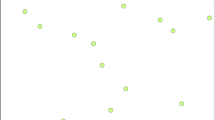Abstract
This paper proposes an energy-efficient routing mechanism by introducing intentional mobility to wireless sensor networks (WSNs) with obstacles. In the sensing field, Mobile Data Collectors (MDCs) can freely move for collecting data from sensors. An MDC begins its periodical movement from the base station and finally returns and transports the data to the base station. In physical environments, the sensing field may contain various obstacles. A research challenge is how to find an obstacle-avoiding shortest tour for the MDC. Firstly, we obtain the same size grid cells by dividing the network region. Secondly, according to the line sweep technique, the spanning graph is easily constructed. The spanning graph composed of some grid cells usually includes the shortest search path for the MDC. Then, based on the spanning graph, we can construct a complete graph by Warshall-Floyd algorithm. Finally, we present a heuristic tour-planning algorithm on the basis of the complete graph. Through simulation, the validity of our method is verified. This paper contributes in providing an energy-efficient routing mechanism for the WSNs with obstacles.









Similar content being viewed by others
References
Fu HL, Chen HC, Lin P (2012) Aps: Distributed air pollution sensing system on wireless sensor and robot networks. Comput Commun 35(9):1141–1150
Shen Z, Pan X, Huang C, Feng J, Zhao Y, Gao M, Ni LM (2013) Energy consumption monitoring for sensor nodes in snap. Int J Sensor Netw 13(2):112–120
Cuevas-Martinez J, Canada-Bago J, Fernandez-Prieto J, Gadeo-Martos M (2013) Knowledge-based duty cycle estimation in wireless sensor networks: Application for sound pressure monitoring. Appl Soft Comput 13 (2):967–980
Dong M, Liu X, Qian Z et al (2015) QoE-ensured price competition model for emerging mobile networks. IEEE Wireless Commun 22(4):50–57
Zhou B, Yang S, Nguyen TH, Sun T, Grattan KTV (2014) Wireless sensor network platform for intrinsic optical fiber pH sensors. IEEE Sensors J 14(4):1313–1320
Dong M, Ota K, Yang LT et al (2014) Mobile agent-based energy-aware and user-centric data collection in wireless sensor networks. Comput Netw (Elsevier) 74(B):58–70
Guo ST, Wang C, Yang YY (2014) Joint mobile data gathering and energy provisioning in wireless rechargeable sensor networks. IEEE Trans Mob Comput 13(12):2836–2852
Zhao M, Yang YY, Wang C (2015) Mobile data gathering with load balanced clustering and dual data uploading in wireless sensor networks. IEEE Trans Mob Comput 14(4):770– 785
LJ, YY, WC (2015) Mobility assisted data gathering with solar irradiance awareness in heterogeneous energy replenishable wireless sensor networks. Comput Commun 69:88– 97
Zhou H, Shenoy N, Nicholls W (2002) Efficient spanning tree construction without delaney triangulation. Inf Process Lett 81(5):271–276
Ma M, Yang YY, Zhao M (2013) Tour planning for mobile data-gathering mechanisms in wireless sensor networks. IEEE Trans Veh Technol 62(4):1472–1482
LG Xie Y, Shi Y, Hou T et al (2015) Multi-node wireless energy charging in sensor networks. IEEE/ACM Trans Network 23(2):437–450
Wang YC (2014) A two-phase dispatch heuristic to schedule the movement of multi-attribute mobile sensors in a hybrid wireless sensor network. IEEE Trans Mob Comput 13(4):709– 722
Wang YC (2012) Efficient dispatch of multi-capability mobile sensors in hybrid wireless sensor networks. In IEEE VTS Asia pacificwireless communications symposium (APWCS)
Jea D, Somasundara AA, Srivastava MB (2005) Multiple controlled mobile elements (data mules) for data collection in sensor networks. In: Proc. IEEE/ACM Int. Conf DCOSS
Gu Y, Bozdag D, Ekici E (2006) Mobile element based differentiated message delivery in wireless sensor networks. In: WoWMoM
Tunca C, Isik S, Yunus Donmez M, Ersoy C (2014) Distributed mobile sink routing for wireless sensor networks: A survey. IEEE Commun Surveys Tutor 16(2):877–897
Shwetha GK, Behera S, Mungara J (2012) Energy-balanced dispatch of mobile sensors in hybrid wireless sensor network with obstacles. IOSR J Comput Eng 2(1):47–51
Shalini Kumari HA, Shivanna K (2012) Dispatch of mobile sensors in the presence of obstacles using modified Dijkstra algorithm. Int J Comput Eng Res 2(5):1458–1461
Yun Y, Xia Y (2010) Maximizing the lifetime of wireless sensor networks with mobile sink in delay-tolerant applications. IEEE Trans Mob Comput 9(9):1308–1318
Ai C, Guo L, Cai Z, Li Y (2009) Processing area queries in wireless sensor networks. In: International conference on mobile ad-hoc and sensor networks
Peng IH, Chen YW (2013) Energy consumption bounds analysis and its applictions for grid based wireless sensor networks. J Netw Comput Appl 36(1):444–451
Xu K, Takahara G, Hassanein H (2006) On the robustness of grid-based deployment in wireless sensor networks. In: Proceedings of the 2006 international conference on wireless communications and mobile computing
Zhou Z, Tang J, Zhang L, Ning K, Wang Q (2014) EGF-tree: An energy-efficient index tree for facilitating multi-region query aggregation in the internet of things. Person Ubiq Comput 18(4):951–966
Shen Z, Chu CCN, Li Y-M (2005) Efficient rectilinear Steiner tree construction with rectilinear blockages. In: Proceedings of the IEEE international conference on computer design conference
Bondy JA, Murthy U (1976) Graph theory with applications. Elsevier, New York
Heinzelman WR, Chandrakasan AP, Balakrishnan H (2002) An application-specific protocol architecture for wireless microsensor networks. IEEE Trans Wireless Commun 1(4):660–670
Acknowledgments
This work was supported by the National Natural Science Foundation of China (no. 61273131) and the Natural Science Foundation of Jiangsu Higher Education Institutions (no.16KJB520003). JSPS KAKENHI Grant Number JP16K00117, JP15K15976.
Author information
Authors and Affiliations
Corresponding author
Rights and permissions
About this article
Cite this article
Xie, G., Ota, K., Dong, M. et al. Energy-efficient routing for mobile data collectors in wireless sensor networks with obstacles. Peer-to-Peer Netw. Appl. 10, 472–483 (2017). https://doi.org/10.1007/s12083-016-0529-1
Received:
Accepted:
Published:
Issue Date:
DOI: https://doi.org/10.1007/s12083-016-0529-1




